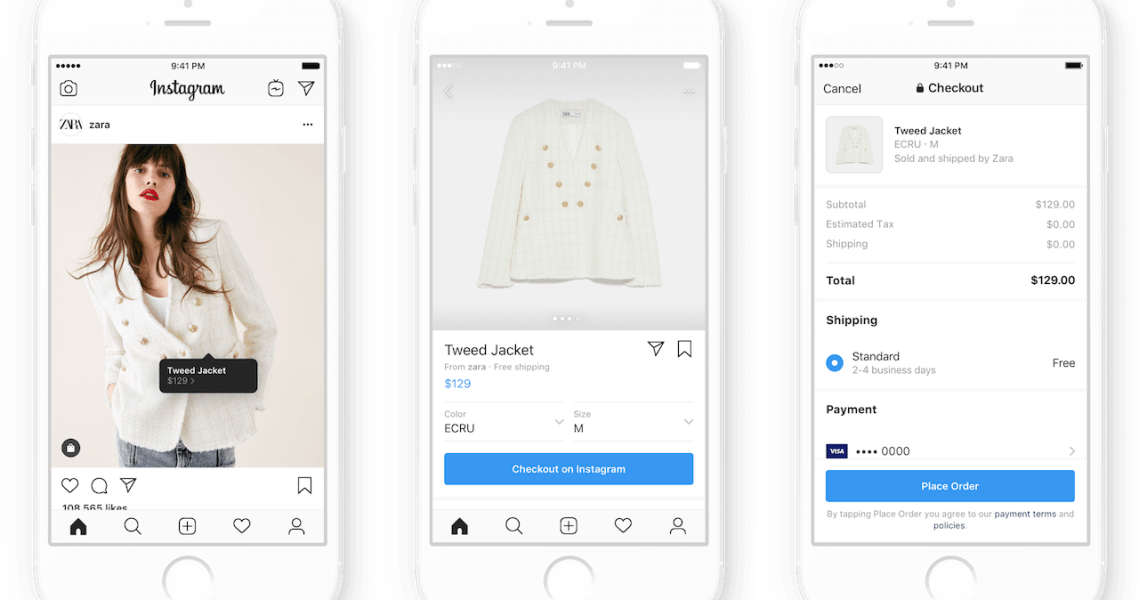Roughly one year into beta-testing Instagram Checkout — a feature that allows users to make a purchase directly in the app — the platform is slowly adding more brands to its slate.
Instagram first launched the feature with 26 brands in March 2019; initial partners included Nike, Adidas, Outdoor Voices, Oscar de la Renta and Zara. In the last 11 months, an onslaught of new companies have joined Checkout. Abercrombie, Hollister, SoulCycle, Joe’s Jeans, Steve Madden, Micheal Stars and Rebecca Minkoff all added Checkout to their social strategy as early as fall 2019. However, the feature is still not open to all brands.
The move to add brands slowly is deliberate on Facebook’s part, according to COO Sheryl Sandberg who spoke about the feature during Facebook’s fourth-quarter earnings call. Sandberg said hundreds of businesses in the U.S. are now testing Checkout, but that the company is being methodical before launching the feature to the some 140 million business globally on Instagram.
“We’re taking the time to get this right and growing slowly so people and advertisers can benefit over the long term,” Sandberg said on the call. Instagram generated $20 billion in advertising revenue in 2019.
For Michael Stars, which launched Checkout in December 2019, the company is already seeing daily conversions on the platform, said Sudie Smith, director of e-commerce and digital marketing. Prior to gaining access to the in-app feature, the brand was using the shopping feature but found “conversions were few and far between,” Smith said. Now, conversions are picking up, but it’s still relatively slow.
“We are very focused on what our top sellers are. T-shirts is such a big category for us, so we do a lot of shoppable posts around those items. We just did one [on Tuesday] of our best-selling tank in multiple colors. I saw three conversions come in so far, which is our best day so far on Checkout,” Smith said.
Being a Checkout-enabled brand does seem to have it perks at this stage, especially on a platform that is increasingly saturated with businesses and brands. Beyond making the shopping experience easy for customers on mobile, Instagram is promoting many of Checkout’s brands within its Explore page.
First, when users click the “Shop” tab on their Explore page, Instagram’s @shop team has started to post curated product recommendations in the top right corner of the page. When clicked, users see a selection of products from only Checkout-enabled beauty brands. Currently one labeled “Winter Glow-up” includes a hair and body shine mist from Ouai, liquid highlighter drops from Flesh Beauty, and a shimmer powder and lip gloss by KKW Beauty.
Creators on the platform are also gaining access to Checkout, through brands. Influencers that have partnered with brands on paid Instagram posts are now able to tag Checkout-enabled products in their own feeds. Maddy Ciccone (40,400 followers), a SoulCycle instructor and fitness influencer, has been posting shoppable posts to her feed since December. In these posts, she’s wearing SoulCycle’s products — like a new $128 hoodie — that her followers can buy in the app simply by tapping the product tag in the photo. Revolve and LPA have also partnered with creators on Checkout-enabled posts.
SoulCycle started using Checkout in December 2019, “as a way for us to participate in drop culture, and empower our instructors to engage with the platform in a way that is mutually beneficial,” said Caroline Gogolak, vp of retail at SoulCycle.
SoulCycle’s retail business increased nearly 14% from 2018 to 2019, with its e-commerce business increasing nearly 70% last year, Gogolak said.
“Participating in Instagram Checkout fit naturally into the overall DTC pivot we’ve implemented over the past few years, which focused on creating a strategy across channels that reflects how people discover new products today,” she said.
Another way Instagram is promoting brands using Checkout is through companies that don’t yet have access to the feature. When a user clicks on a product that is not Checkout-enabled, say a dress from Reformation, they’re taken to a product page within the app for that specific item. Below the product is a button that takes the user to that dress on Reformation’s website. But if the user scrolls down on that product page within Instagram, there is often a section of similar items to buy. Those products, at this point, are all from Checkout-enabled brands. Similar brands being pulled in this example include Revolve, LPA, Bebe, Superdown and Planet Blue.
Although many big-name brands — especially in fashion and beauty — are flocking to Checkout, some still approach the concept with caution. Currently, when a customer makes a purchase in the app, all communication about the order is done via email through Instagram — not the brand. Thus, there is no access to customer data.
“The real battle [with Checkout] is gaining customer data,” said Eva Poureshagh, director of marketing at global e-commerce company Scalefast. “When consumers shop through Instagram Checkout rather than a brand’s native platform, their information is stored in the app and not accessible to the company outside of order fulfillment when users opt out of sharing their email address for marketing purposes. There is not a chance for the marketing team to capture a consumer’s contact information for direct marketing and relationship building.”
A DTC brand marketer, who asked to remain anonymous, echoed these concerns. The marketer said this particular DTC company decided not to move forward with Instagram’s Checkout feature after initially being approached by the platform in fall 2019. At the time, Instagram also wanted to charge a 5% transaction fee on all purchases, which felt too high for the brand.
A spokesperson for Facebook said: “Instagram is testing a selling fee of 5%. This helps us fund programs and products that help make Checkout possible, as well as offset transaction-related expenses.”




